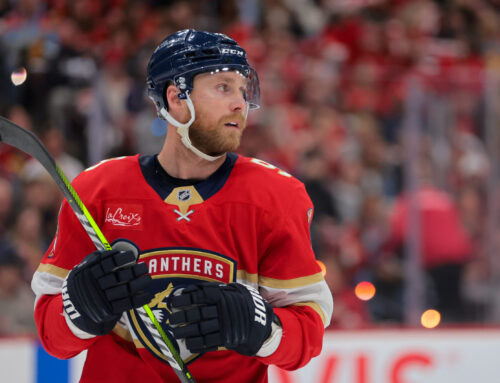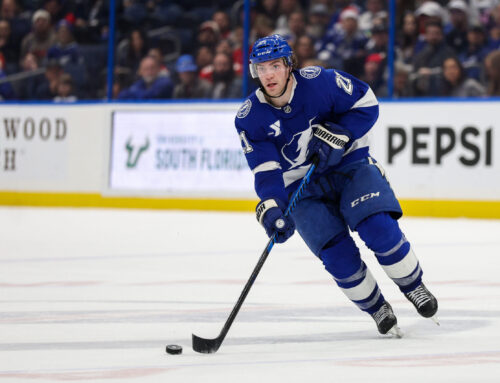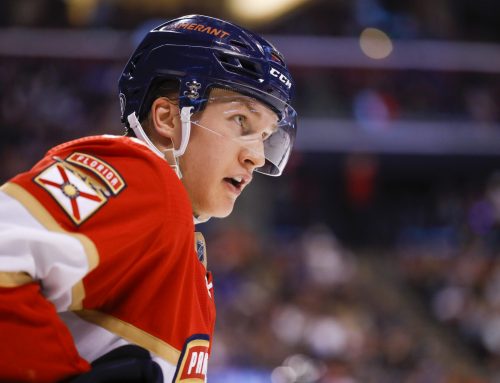
Which of these slow starters is the better bet to turn it around?
This week’s combatants (Andrew Ladd and Loui Eriksson) both signed 2016 UFA deals for $35M+, and now have something else in common – major early struggles (55 goals in 180 games last season – ZERO through their first 18 for 2016-17). This has poolies wondering if their current situations signify a post-UFA production downturn, or instead represent buy low opportunities. Never fear – Cage Match will point you in the right direction!
Career Path and Contract Status
Ladd, who turns 31 next month, was drafted 4th overall by Carolina in 2004. By age 20 he’d not only made it to the Hurricanes but played 17 postseason games during their Stanley Cup run. That was the highlight of his tenure in Carolina, which ended with 50 points in 137 games and him being dealt to Chicago. Although he only scored 99 points in 184 games with the Hawks, he won his second Cup before turning 25. He was then shipped to Atlanta and inserted into a sustained top six role; that paid dividends via a combined 60 point full season scoring pace from 2010-11 through 2014-15 before he faltered in 2015-16.
Eriksson, 31, was picked 33rd overall by Dallas in 2003. Although Eriksson made it stateside by 2005, he played part of every season in the AHL until his 63 point 2008-09 with Dallas. From there, Eriksson tallied 71-73 points in each of the next three campaigns and was one of a select few to land within the top 25 in scoring each season. After a disappointing 2012-13, Eriksson went to Boston as the centerpiece of the Tyler Seguin trade. Eriksson’s tenure in Beantown was subpar (84 points in 142 games) until 2015-16, when he scored 63 points, including 30 goals (two fewer than his prior two seasons combined).
Ladd’s new deal runs through 2022-23 and dings the cap at $5.5M per season, while Eriksson’s is slightly more expensive ($6M) but ends in 2021-22.
Ice Time
|
Season |
Total Ice Time per game (rank among team’s forwards) |
PP Ice Time per game (rank among team’s forwards) |
SH Ice Time per game (rank among team’s forwards) |
|
2015-16 |
19:27 (A.L. – WPG) – 3rd 17:14 (A.L. – CHI) – 6th 19:28 (L.E.) – 3rd |
2:49 (A.L. – WPG) – 3rd 2:21 (A.L. – CHI) – 4th 2:54 (L.E.) – 3rd |
2:00 (A.L. – WPG) – 2nd (tied) 1:19 (A.L. – CHI) – 8th 1:51 (L.E.) – 4th |
|
2014-15 |
20:04 (A.L.) – 1st 18:28 (L.E.) – 1st |
3:12 (A.L.) – 2nd (tied) 2:24 (L.E.) – 2nd |
1:47 (A.L.) – 4th 1:36 (L.E.) – 3rd |
|
2013-14 |
19:43 (A.L.) – 3rd 16:31 (L.E.) – 5th |
2:43 (A.L.) – 1st 1:57 (L.E.) – 5th |
2:03 (A.L.) – 3rd 1:25 (L.E.) – 6th |
|
2012-13 |
19:40 (A.L.) – 3rd 20:07 (L.E.) – 1st |
2:39 (A.L.) – 1st 3:14 (L.E.) – 4th |
1:24 (A.L.) – 5th 1:37 (L.E.) – 5th |
Ladd’s numbers are fairly consistent, which is a bit concerning given his struggles last season. Moreover, the lack of higher Ice Time numbers for 2012-13 makes it possible his nearly point per game output from that abbreviated season was influenced by unsustainable good luck.
For 2016-17, through Halloween Ladd was averaging only 18:35 per game; however, he’s seeing plenty of PP Time (2:53) and has been relieved of nearly all unproductive SH duty. If this continues, it would mean an extra 1:00+of productive Ice Time per game despite lower overall Ice Time. Nevertheless, on 10/30 he was off the top line and played only 12:48, which bears watching.
Eriksson had a rude awakening in Boston, as gone was the 20:00+ per game he’d received in Dallas; even in 2014-15 when he led Bs forwards, it was only 18:28. The good news is his 2015-16 scoring spike “checks out” as it coincided with jumps in Total and PP Ice Time versus his prior Boston seasons. Also, thus far in Vancouver he’s skating 19:17 per game and for nearly 60% of the team’s PP minutes. That being said, on 10/29 he was removed from PP1, and, like Ladd, received by far his lowest Total Ice Time for the season. That too bears watching.
Overall, this paints a picture of two players who, although underperforming out of the gate, are positioned to see their scoring rebound, especially since with their contracts and lack of forward depth on their teams it’s very unlikely their Total and PP Times would see anything but a temporary drop.
Secondary Categories
All 2015-16 data for Ladd is consolidated to reflect his time with both Winnipeg and Chicago.
|
Season |
PIMs (per game) |
Hits (per game) |
Blocked Shots (per game) |
Shots (per game) |
PP Points (per game) |
|
0.46 (A.L.) 0.14 (L.E.) |
1.98 (A.L.) 0.27 (L.E.) |
0.54 (A.L.) 0.41 (L.E.) |
2.32 (A.L.) 2.24 (L.E.) |
0.18 (A.L.) 0.20 (L.E.) |
|
|
2014-15 |
0.73 (A.L.) 0.17 (L.E.) |
2.61 (A.L.) 0.36 (L.E.) |
0.47 (A.L.) 0.28 (L.E.) |
2.76 (A.L.) 2.08 (L.E.) |
0.23 (A.L.) 0.13 (L.E.) |
|
2013-14 |
0.89 (A.L.) 0.10 (L.E.) |
1.97 (A.L.) 0.19 (L.E.) |
0.54 (A.L.) 0.21 (L.E.) |
2.42 (A.L.) 1.88 (L.E.) |
0.15 (A.L.)
📢 advertisement:
0.18 (L.E.) |
|
2012-13 |
0.56 (A.L.) 0.16 (L.E.) |
2.04 (A.L.) 0.12 (L.E.) |
0.54 (A.L.) 0.37 (L.E.) |
2.52 (A.L.) 2.16 (L.E.) |
0.12 (A.L.) 0.21 (L.E.) |
Ladd is among a select few forwards who excel in PIM, Hits and SOG while chipping in with solid goals and points. How rare are Ladd’s level of across the board category contributions? Looking at combined data from 2012-13 to 2015-16, he was one of just three forwards who averaged 0.3+ Goals, 2.3+ SOG, 2.1 Hits, and 0.7 PIM per game plus had at least one 60+ point individual season, the other two being Alex Ovechkin and Chris Kunitz.
From 2007-08 to 2011-12, there were six players who met the same criteria: Ovechkin again, plus Shane Doan and Dustin Brown. The other three were then age 30+ players Ryan Malone, Brendan Morrow, and Erik Cole, who quickly saw their production dry up and are out of hockey. Does this mean Ladd, who’ll soon be 31, will suffer a similar fate? Not necessarily; but this data cannot be entirely disregarded.
Turning to Eriksson, his Hits and PIM outputs are almost uniquely terrible; even when he’s producing, they make him a tough pill to swallow in leagues with these categories. His Blocks, however, are decent. In terms of his SOG total rising in his past two seasons, that was reassuringly in line with his Ice Time increasing each of those years.
Luck-Based Metrics
Here too, 2015-16 data for Ladd reflects his time with Winnipeg and Chicago.
|
Season |
Personal Shooting Percentage |
Team Shooting % (5×5) |
IPP (5×5) |
IPP (5×4) |
Offensive Zone Starting % (5×5) |
|
2015-16 |
13.8% (A.L.) 16.3% (L.E.) |
7.58% (A.L.) 7.87% (L.E.) |
68.4% (A.L.) 74.0% (L.E.) |
54.2% (A.L.) 45.5% (L.E.) |
51.9% (A.L.) 51.2% (L.E.) |
|
2014-15 |
11.9% (A.L.) 13.0% (L.E.) |
7.77% (A.L.) 7.46% (L.E.) |
81.8% (A.L.) 71.8% (L.E.) |
63.3% (A.L.) 43.5% (L.E.) |
55.5% (A.L.) 49.1% (L.E.) |
|
2013-14 |
10.7% (A.L.) 8.7% (L.E.) |
8.26% (A.L.) 8.25% (L.E.) |
72.0% (A.L.) 62.9% (L.E.) |
47.6% (A.L.) 64.7% (L.E.) |
51.6% (A.L.) 59.2% (L.E.) |
|
2012-13 |
12.2% (A.L.) 11.5% (L.E.) |
10.42% (A.L.) 7.65% (L.E.) |
77.5% (A.L.) 68.0% (L.E.) |
50.0% (A.L.) 57.1% (L.E.) |
50.0% (A.L.) 52.5% (L.E.) |
Remarkably, both players had at least one very productive season among the last three despite 5×5 team shooting percentages well lower than the roughly 9.00% that represents the normal leaguewide average. That metric also more than offsets their personal shooting percentage, which otherwise might look a bit high, particularly over the last two seasons. But sure enough – Ladd’s Shooting % numbers were unsustainably high in 2012-13, when he posted 46 points in 48 games.
IPP at 5×5 is strong for both, but a bit more so for Ladd. Not only was Ladd’s 70%+ in three of these seasons, but his average was 75%. Also, it’s been 70%+ in seven of his last nine seasons (68.4% and 67.3% in the other two), yet not so far over 70% as to signify unsustainable good luck. Moreover, Ladd’s 70%+ 5×5 IPP, in addition to signifying he drives offense, could mitigate against his production falling off a cliff ala Malone, Morrow, Brown, or Cole, or dropping ala Doan and Kunitz, especially since each of them had at 70%+ 5×5 IPP in only two or three of their last eight NHL seasons.
Meanwhile, Eriksson’s 5×5 IPP is nothing to sneeze at. Although it was below 70% in two of these four seasons, it was above 70% in his most recent two and his collective average over this stretch was 69.2%. And like Ladd, Eriksson’s 5×5 IPP history is solid, with it being between 82.1% and 75.5% each season from 2008-09 through 2011-12.
As for why Ladd has started 2016-17 so slow, look no further than his 5×5 team shooting %, which is 1.89%! Plus, although I’m no longer charting PDO/SPSV, his for 2016-17 is 945, which is far below the low end of normal. In short, had Ladd and his linemates received fewer unlucky bounces he’d be looking at several more points by now.
Eriksson’s 2016-17 team shooting % at 5×5 (3.77%) and PDO/SPSV (969) are quite low also, but still well below Ladd’s. So although both players – on paper – seemingly are experiencing unsustainable bad luck, what Eriksson is going through still apparently pales in comparison to Ladd.
One additional point about Eriksson – just as there’s concern for Ladd based on player comparables, Eriksson has some data working against him too. Eriksson tallied 30 goals last season at age 30; and of the 75 forwards who’ve posted at least one 30+ goal season at age 30+since 2000-01, 60% (i.e., 45) didn’t hit the 30+ goal mark again after that. Moreover, if we look at just players who, like Eriksson, had a 30+ goal season at age 30 or older after having posted 30+ goals at least once before, but not in any of the immediately preceding five seasons (Eriksson’s only other 30+ goal season was in 2008-09), we see mostly players whose scoring dropped precipitously within a year or two after doing so: Donald Audette, Scott Young, Steve Sullivan, Rod Brind’Amour, Fredrick Modin, Michael Ryder and Erik Cole.
Who Wins?
In fantasy hockey, players can – and do – start slow. Just last year Elias Lindholm, Sean Couturier, and Alexander Wennberg had a total of five points in their first combined 45 games, then finished strong (31 points in Couturier’s last 40 games; 37 in Lindholm’s final 64; 39 in Wennberg’s last 54). But they’re all age 23 or younger, and none just inked a huge UFA deal…..
Overall, if you own either Ladd or Eriksson in a keeper, they both hold risk – perhaps even more so than a normal 30-31 year old. Once they hit a sustained hot streak I’d consider moving either one for pre-breakout talent, unless your team figures to be competing for the title this year. In one year leagues, however, I think reports of their imminent demise have been exaggerated given their unsustainable bad luck and, just as important, their large contracts and lack of viable competition for prime top six roles.
In terms of a winner, I’m going with Ladd, who likely could be obtained either for free (waiver wire) or likely for a bargain from a panicked owner. Not only has Ladd been victimized more by bad luck than Eriksson, but notwithstanding his stint on a different line on 10/30, he’ll likely remain as tethered to Tavares as Eriksson is to the Sedins, and the reality is Tavares is simply a far better player than either Sedin at this point. Also, Ladd’s especially slow start represents “sunk costs” you wouldn’t have to endure if you get him now. To put it another way, if Ladd still manages to score 50 total points this season, that would mean 49 in his 73 remaining games (i.e., a 55 point scoring pace). And Ladd is a competitor, meaning that even if his skill is eroding faster than one would’ve imagined, you have to think he’ll put in the hard work to keep him – and the poolies who own him in leagues – above water.
As for Eriksson, I can’t help being a bit more concerned his production burst last season could’ve been tied to ensuring a large UFA payday, especially since it came amid higher scoring, SOG, and 5×5 IPPs – at age 30 – versus his first and second seasons with the Bs. With that comes bigger concern that he’s less likely to dig out of his hole for 2016-17. To me, Eriksson has at least as many question marks as Ladd, plus likely would cost more to “buy low” on because his struggles haven’t been as pronounced.
5 Comments
Leave A Comment
You must be logged in to post a comment.





 EDM
EDM STL
STL ANA
ANA BUF
BUF DET
DET NYI
NYI CAR
CAR MIN
MIN PIT
PIT T.B
T.B

I have Eriksson in my pool and it is a deep keeper pool, my question is should I drop Eriksson and gamble on a young kid such as a Brandon Pirri or Colton Sceviour. The thing I liked about Eriksson is that he is a dual eligible player but he is having a terrible start to the season.
Sorry to just be replying now. It’s a toughie. If it’s a multi-cat, then maybe drop him and try to stream players in the slot he used to occupy. But if it’s points only then probably best to stick it out given that you’ve already suffered through a down stretch.
Agreed. Eriksson ‘s saving grace is the LW/RW. Really helps in maximizing the starts. I’m benching him. I’m in a deep one year roto pool, with blocks and hits and sog, but it’s hard to drop a guy that’s still 60 percent owned when the top FAs are only 30 percent owned.
Thanks for the in-depth analysis. Gonna be patient with Ladd, one of my multi-cat-favs of recent years, then…
Glad you liked the piece. I can’t blame anyone for whatever they decide to do with Ladd at this point, but after researching the article I think he cannot be this bad overnight. He should rebound.